In my last post, I opened a discussion on plant form with a look at columnar or fastigiate forms and their use in the landscape. Today I continue this discussion with two additional forms – Pyramids and Vases.
Pyramidal/Conical
Pyramids or cones are wider at the bottom, becoming narrower and tapering to a point at the top. Their geometric form gives a garden solidity, structure and definition. In our climate, it is during the long winter months that pyramids carry the most visual weight – most of the pyramids we see are evergreens, which are dense, stiff needled and weighty in appearance. As well, pyramidal forms carry their weight close to the ground – this wide-bottomed shape means that visually they are very grounding (anyone else start silently singing the refrain from a certain song?)
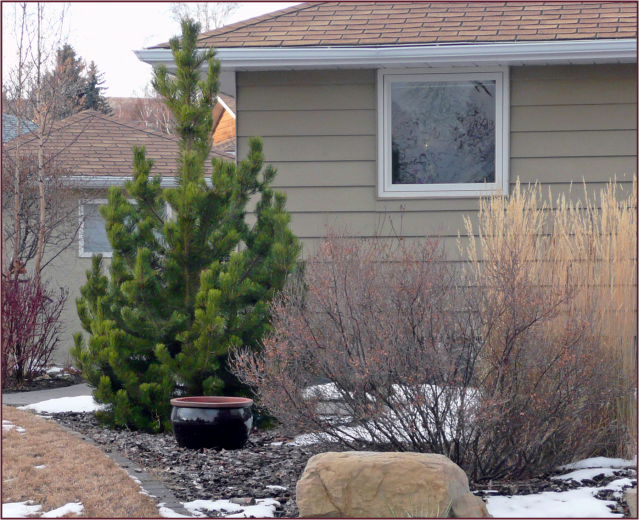
A solid green pyramid, which I suspect is Pinus mugo ‘Tannenbaum’, stands out in this winter landscape, firmly anchoring the more yielding forms of leafless woodies and dried grasses. Photo: Sue Gaviller
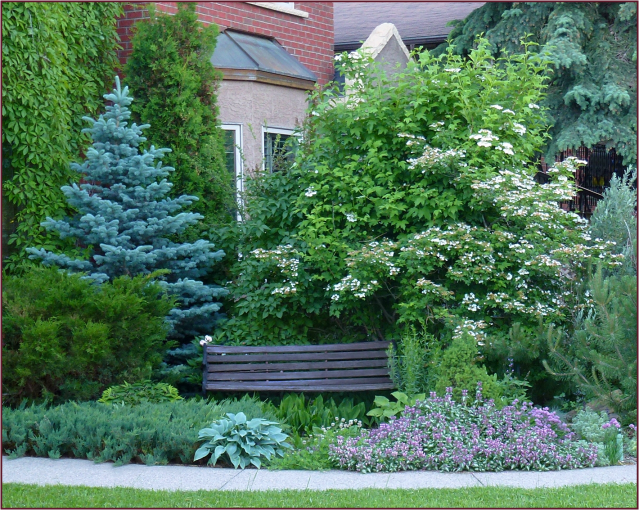
The pyramidal form of blue spruce provides definition and structure to this pretty vignette.
Photo: Sue Gaviller
Pyramids can be quite variable in size and proportion – some are short and squat, some tall and narrow and some in between. This means their use in the landscape is also variable. A tall narrow pyramid will behave more like a columnar form, making a striking vertical accent or effectively framing a view or entrance, whereas the more wide-bottomed specimens won’t have this effect and better serve as anchors with their bottom heavy appearance (there’s that song again).
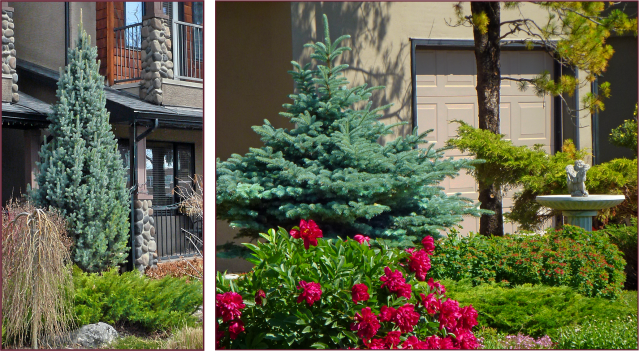
Left – A tall narrow pyramid like Picea pungens ‘Fastigiata’ makes a dramatic vertical feature.
Photo: Pat Gaviller.
Right – Short and squat, dwarf cone-shaped Picea pungens (likely cv. ‘Montgomery’) steadies this pretty composition. Photo: Sue Gaviller
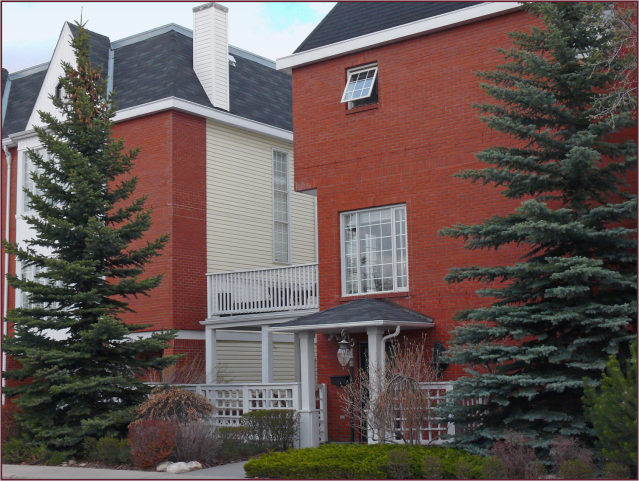
Two Picea pungens var. glauca create a nice frame – their size, form and texture provide solid structure, matching that of the large brick building. Photo: Pat Gaviller.
Pyramids are also useful for repeating the shape of roof peaks or mountains in the background. As well, their natural geometry lends itself to use in formal landscapes, where parterres and hedges are clipped into strong geometric forms.
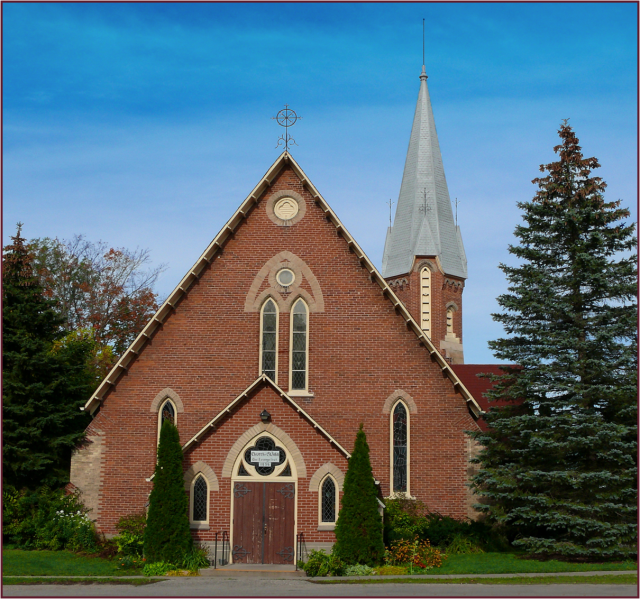
The narrow pyramidal forms of two cedars effectively repeat the shape of the church steeple (and frame its entrance), while the broader spruce repeats the form of the roof peak. Photo: Pat Gaviller
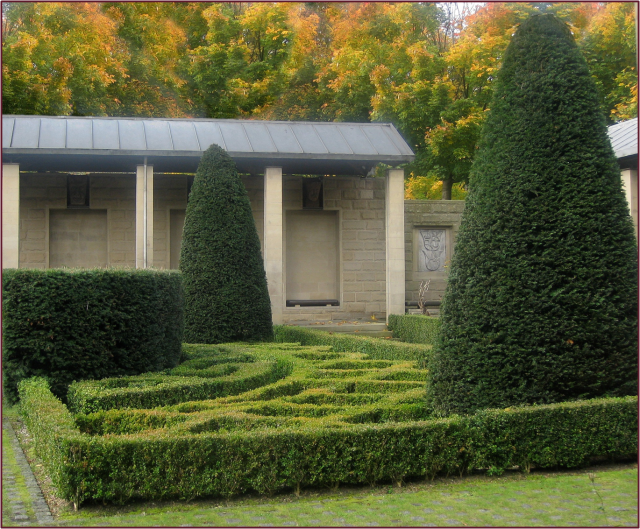
Pyramidal forms fit well into formal designs. Photo: Evelyn Steinberg
Keep in mind that the more narrow the pyramid, the more it will perform like a columnar form, so the same guidelines will apply regarding its overuse. Otherwise this form can be used fairly freely in the landscape, remembering that evergreen material shouldn’t comprise more than about half of your plant material due to its weight. And of course scale, proportion and all the other design principles still apply.
Vase shaped
Vases are inverted pyramids – narrow at the bottom and flaring out towards the top. They are graceful and elegant, making them excellent feature trees/shrubs. Like pyramids they vary somewhat in proportion, with some being quite slender and others much broader. A very narrow specimen can make an elegant vertical accent, frame an entrance or view, or be planted in groups. Just like columns or narrow pyramids, narrow vases shouldn’t be overused – because they stop the eye and draw it up, the same guidelines will apply as for columnar forms, though a narrow vase is less dramatic.
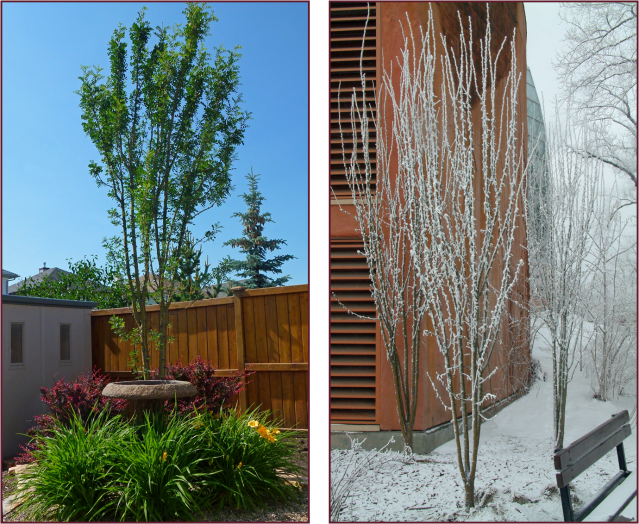
Left – Slender vase-shaped Caragana arborescens ‘Sutherland’, together with a bird bath and Hemerocallis ‘Stella d’Oro’, make a lovely focal vignette in a client’s sunny backyard. Photo: Sue Gaviller.
Right – A trio of Sutherland Caragana also works well. Photo: Jane Reksten.
Broader vases are still graceful but don’t behave as verticals. They can therefore be used liberally throughout a landscape composition – a single specimen though, makes an outstanding feature on its own.
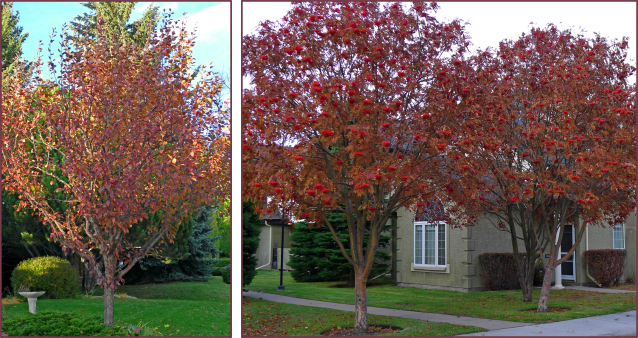
Plants with broad vase form are a beautiful addition to the landscape, whether used singly or grouped.
Left – Malus ‘Thunderchild’. Right – Sorbus decora. Photos: Sue Gaviller
Vase shaped trees planted on either side of a street or walkway create a lovely arching canopy as they meet at the top. If you’ve ever peered down one of Calgary’s elm-lined streets you’ll know what a spectacular sight this is, especially with a dusting of hoar-frost coating the lacy branches of the stately elms.
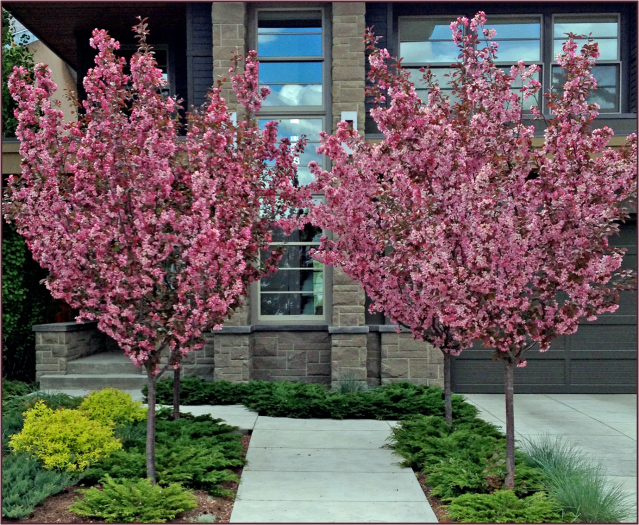
Ornamental crabapple trees have a beautiful vase shape – some very broad and some more narrow. I love how the designer has utilized the form in this landscape, both framing the walkway and creating the arched canopy over it. Photo: Gabe Girimonte.
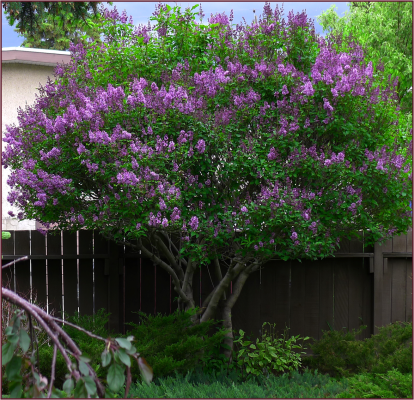
Syringa prestoniae grows naturally in a globe shape, but looks lovely pruned into a broad vase. Photo: Sue Gaviller
Vase shapes are a favourite with many gardeners – in fact so enamoured are we of this form that we’ll often prune a shrub into a vase shape, and labour to maintain it, despite the fact that its natural growth habit is otherwise.
I’ve seen various shrub species, including Syringa, Prunus, Lonicera and Viburnum, pruned in this manner.
Note too that during the growing season, the leafy canopy of a vase-shaped tree or shrub may affect its form, appearing somewhat like a ball on top of a vase. Whether you then choose to use this plant as a round form or a vase, will depend on how much of its woody skeleton is visible when clothed in foliage. It will also depend on how much of the year it actually has leaves.
Vases and pyramids are important inclusions in your landscape or garden composition. Indeed they work in beautiful concert with each other, fitting together like puzzle pieces.
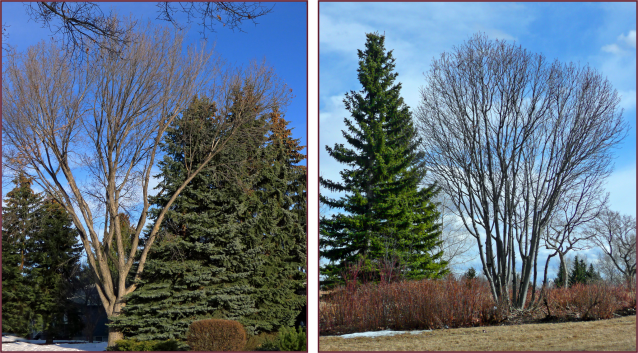
Left – Ulmus americana and Picea pungens var. glauca. Photo: Sue Gaviller
Right – Picea and Prunus sp. Photo: Sue Gaviller
Next post we’ll continue to build our garden sight-line with more plant forms, so y’all come back now, hear?
SueRelated articles
- The Form of Things to Come (notanothergardeningblog.com)

Great post Sue and very informative. The Pinus mugo ‘Tannenbaum’ is a beautiful addition to the landscape as are many of your other selections. I like how you are framing the entrances with the the pyramidal and flowering trees creating an inviting entrance. I always enjoy visiting and reading your posts!
Hi Lee,
Thanks for your kind comments although I can’t take credit for all the designs I use in my posts. I do sometimes use my own yard or clients’ yards as examples, but my goal is really to showcase good design as opposed to just my own designs. I see lots of great examples when I’m out and about – so when I see something I like, I snap a photo of it.
Anyways, glad you’re enjoying the blog and thanks for visiting!
Sue
Hi Sue, Great design lesson. Though design is one of my biggest interests in gardening, I must confess that I haven’t paid nearly enough attention to shapes. My favourite inspiration is the second image. I love the mix of colors and textures. Even if it went for a time with no flowers, it would look really beautiful.
You asked in your comment about photographing local gardens. The most recent gardens I have shown are all private homes and not open to the public. There are always garden tours on the go somewhere in the GTA and that gets you into some private spaces.
Have you ever been to Lost Horizons in Acton? It is a plant lover’s nursery with an incredible display garden. How about the Music Garden right on the waterfront? I always love visiting Edwards Gardens and the RBG in Hamilton. (see previews in my More Ontario Gardens below the header)
Hi Jennifer,
Just this morning I was thinking that I hadn’t checked back yet for an answer to the question I’d asked, so thanks for your reply – the Music Garden and RBG I’d already planned to visit, but thanks for your other suggestions. You have a great blog by the way – lovely photos.
Regarding your comment, plant form/shape is a factor many gardeners overlook, not realizing that it can be central to good garden composition – indeed plant form is implicated in most of the design principles (especially dominance and movement), so it really does need to be considered.
The photo you mention is a pretty scene I drive by often, and you’re right, even with nothing blooming it always makes a charming picture.
Thanks again for reading,
Sue
Beautiful photographs and a great blog.
Hi Mike,
Thank-you for your kind comments – always happy to hear that readers enjoy what I offer. I’ll be sure to check out your blog as well.
Thanks for reading,
Sue
Sue,
Hope you enjoy mine too.
Mike